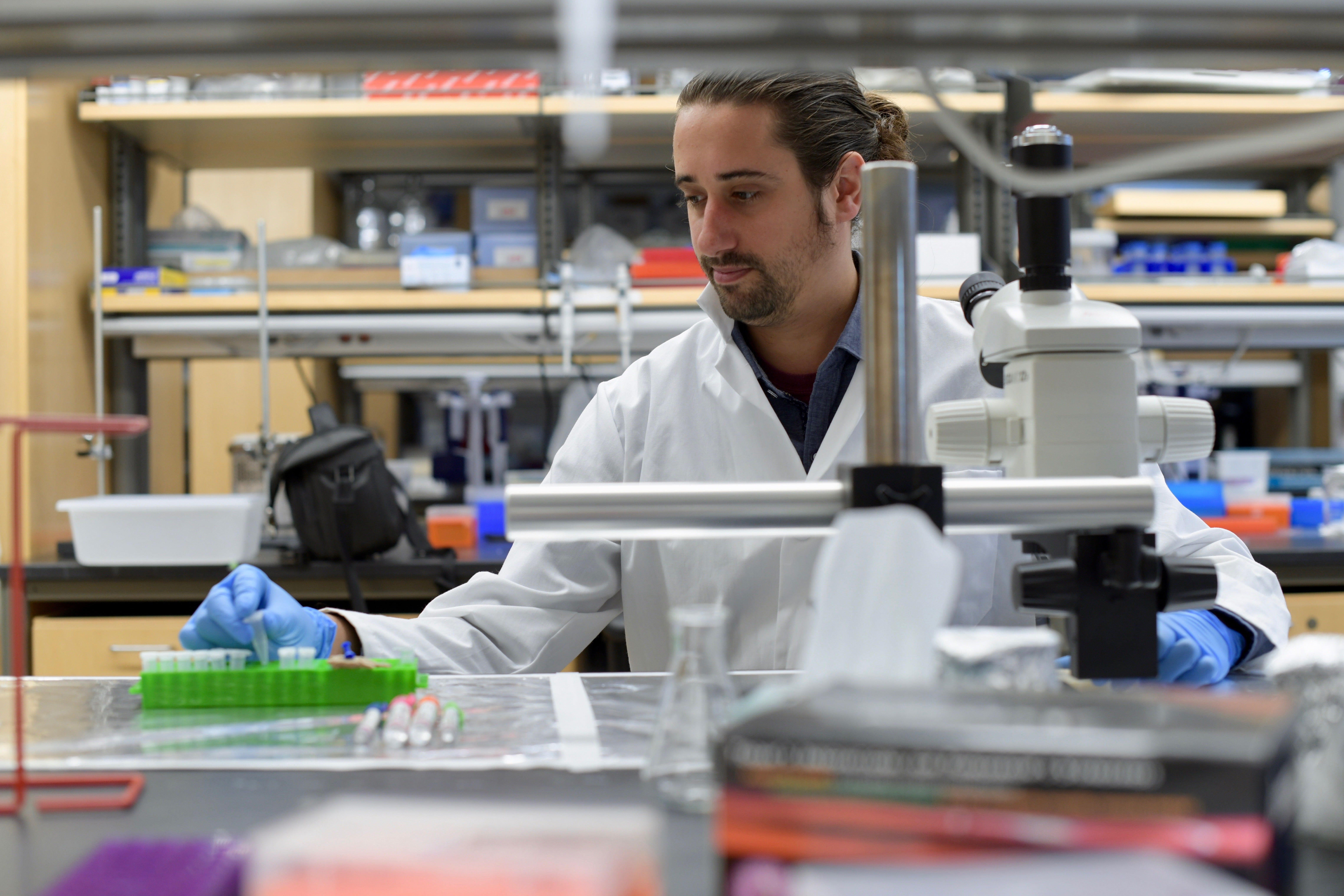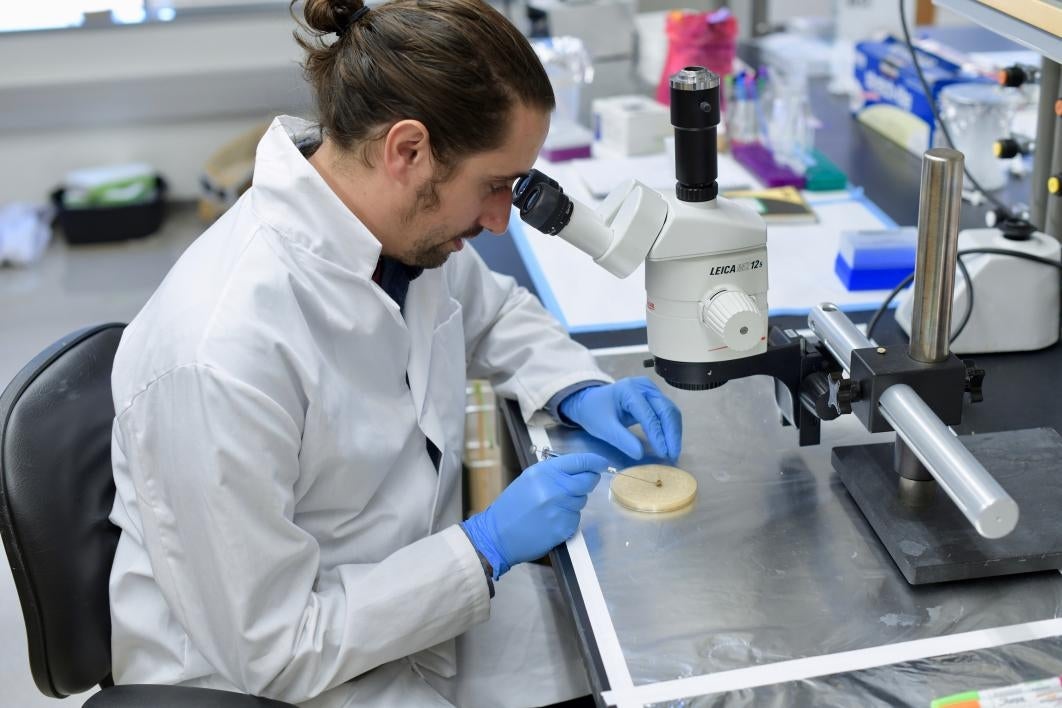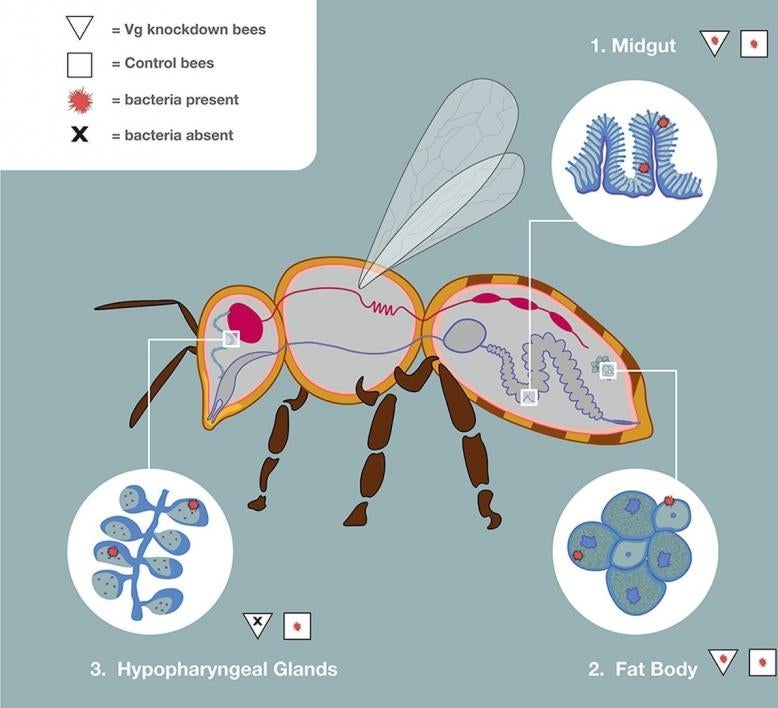Protecting the hive: ASU scientists discover path to colony-level immunity in honeybees

There are more than 20,000 species of bees on earth, all of which serve an important role pollinating our plants, and all of them utilize vitellogenin. Photo by Sandra Leander/ASU
Honeybees frequently make international news, as their global decline threatens the world’s food supply. Since honeybees pollinate the majority of crops that humans use for food, scientists have been searching for a way to maintain healthy bee populations.
Now, researchers with Arizona State University’s School of Life Sciences and the University of Helsinki are one step closer to understanding the complex immune mechanism that protects honeybees from diseases in their environments.
Graduate student Gyan Harwood and his mentor Professor Gro Amdam have discovered that honeybee workers can transfer a type of “immunity memory” to the queen when they are exposed to pathogens during foraging outside the hive.
The findings appear in a paper published Jan. 28 in the Journal of Insect Physiology.
“The cool implications of this are that it opens the possibility that bees have this colony-level immune response where worker bees that are out foraging at flowers may encounter pathogens, and if they are able to successfully fight off the disease, they can potentially transfer these pathogen fragments between individuals and prime their immune system to kick into gear and start fighting these pathogens,” Harwood said. “It’s a way to prime the immune system of all individuals in the hive in a safe way without them being exposed to live pathogens.”
Honeybee immunity
When humans get sick, our complex immune systems not only fight off diseases, they also remember them with antibodies. And mothers can briefly protect their newborns by passing along antibodies against certain diseases through their placenta and breast milk.
But how does this type of transgenerational immunity work in honeybees, which lack antibodies?
ASU graduate student Gyan Harwood studies honeybee colony-level "immunity." Photo: Samantha Lloyd/ASU VisLab
In a previous study, Amdam and her collaborators discovered that honeybee queens can pass immunity to their larvae, essentially “vaccinating” the babies against pathogens in their environment.
However, honeybee queens never leave their colonies except once during youth to mate, and once late in life to find a new colony. This begs the question: How can they vaccinate against pathogens to which they’ve never been exposed?
To understand how they do this, Amdam focused on a protein called vitellogenin.
“There was something missing in our knowledge about honeybee traits, a missing link, a missing ‘it’, and I was trying to find out what ‘it’ was,” Amdam said. “I was reading a lot about this protein, and I read it was very boring. But by the time I learned that, I was kind of in love with the idea that vitellogenin was ‘it’.”
Vitellogenin
Vitellogenin is a more than 700-million-year-old protein found in eggs in species ranging from corals to monotreme mammals and is also found in honeybees. Because of this, it carries a lot of nutrients needed to grow an offspring, causing it to be dismissed as a “lunchbox protein.” Twenty years ago, researchers believed this was all it did.
However, something didn’t add up. More than 700 million years ago, animal eggs didn’t exist. Multicellular organisms were barely beginning to form. So, if this protein was only designed to add nutrients to eggs, why did it exist before eggs did? Did it have another role?
As it turns out, vitellogenin can also bind to these pathogen pieces, allowing honeybee queens to deliver that information into her eggs, preparing her offspring for the pathogens they may encounter in their environment after hatching.
“What’s actually being transferred are little pieces of the pathogens itself,” Harwood said. “Then the offspring can recognize that little piece of the pathogen and realize, ‘Hey, this isn’t from my own body; this is a piece of a pathogen, some foreign threat, so I need to kick my immune system into gear and kill that.’”
Another piece of the puzzle
But if the queens don’t leave the colony, Harwood knew there had to be more to this system and focused on the colony worker bees, which are sterile daughters of the queen. Even though they cannot produce offspring, they still produce vitellogenin and use it to make royal jelly. Royal jelly is produced in workers’ glands and then fed to the queen and larvae. Harwood wondered whether bacteria consumed by the workers would be transported to these royal jelly-producing glands.
To test this, Harwood fed E. coli bacteria labeled with a fluorescent marker to worker bees and imaged tissues involved with nutrient absorption and storage. He also imaged the glands that produce the royal jelly, called the hypopharyngeal glands.
In some of the honeybees, he suppressed their ability to produce vitellogenin. Then, he compared those bees with normal-functioning bees to see where the bacteria pieces were being transported without it.
Harwood found that normal-functioning honeybee workers had fluorescent bacteria pieces in their glands while those with suppressed vitellogenin did not, suggesting that vitellogenin is vital to the pathogen transfer in both the queen and the workers and may be the mechanism through which honeybees are able to “vaccinate” their larvae.
Honeybee vaccine
The potential application of this discovery is a “vaccine” that has been approved in Europe and is near licensing in the United States, which will allow honeybee queen breeders to feed the queens a solution stocked with pieces of diseases that may be harmful to their colonies. This will allow beekeepers to start disease-resistant colonies, strengthening the local honeybee population.
However, the implications of this discovery may be much more widespread.
“Given that it plays such a central role in producing eggs, vitellogenin is basically found in every animal that produces eggs,” Harwood said. “A lot of these immune system functions evolved early in vitellogenin history, so if we can see it in honeybees, it’s likely going to have similar functions in all other animals. This opens all kinds of doors to research how this protein can be facilitating the transfer of disease resistance from mothers to offspring. We’re at the tip of the iceberg right now in showing how important a role this protein plays in pathogen resistance in bees and other animals.”
An ASU School of Life Sciences Training Initiative funded the research, along with the Research Council of Norway and the Academy of Finland.
More Science and technology

Applied Materials invests in ASU to advance technology for a brighter future
For nearly 60 years, global giant Applied Materials has been hard at work engineering technology that continues to change how…

Meet ASU engineering students who are improving health care, computing and more
Furthering knowledge of water resource management, increasing the efficiency of manufacturing point-of-care health diagnostic…

Turning up the light: Plants, semiconductors and fuel production
What can plants and semiconductors teach us about fuel production?ASU's Gary Moore hopes to find out.With the aim of learning how…





